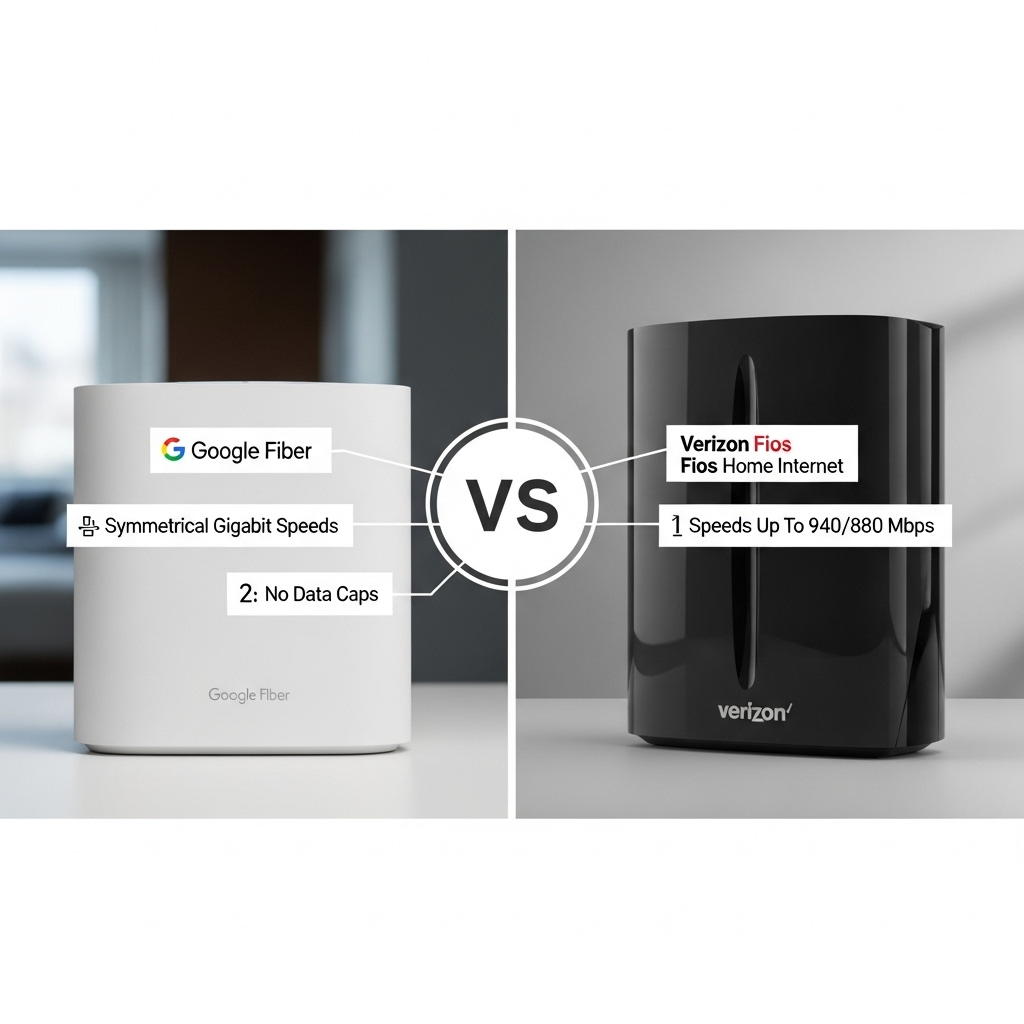Internet service providers > Google Fiber vs. Verizon Fios Home Internet
Choosing between Google Fiber and Verizon Fios means weighing speed against accessibility. While Google Fiber boasts impressive symmetrical speeds, its limited availability contrasts with Verizon Fios's broader coverage, including its 5G home internet option. The decision hinges on your location and internet needs.
This comparison analyzes real-world performance, user feedback, and key differentiators to help you make an informed decision.
Quick Verdict
For users prioritizing raw speed and symmetrical performance, Google Fiber is the clear choice, assuming availability. Verizon Fios caters to a wider audience with its varied plans and wider coverage, presenting a more accessible option for many.
- Google Fiber offers significantly faster symmetrical speeds, but Verizon Fios has broader availability and potentially lower starting prices.
- Verizon Fios provides a 5G Home Internet option, expanding its reach beyond fiber-optic areas, while Google Fiber relies primarily on fiber.
Who Should Choose Which?
Choose Google Fiber if:
Tech enthusiasts and professionals who require ultra-fast upload and download speeds and reside within Google Fiber's limited service area.
Choose Verizon Fios if:
Households seeking reliable internet with diverse plan options and broader availability, especially those in the Northeast and Mid-Atlantic regions or areas covered by Verizon's 5G network.

Key features – Side-by-Side
| Attribute | Google Fiber | Verizon Fios Home Internet |
|---|---|---|
| Starting Price | $70/month (Core 1 Gig) | — |
| Download Speed Range | 1 Gbps - 8 Gbps | — |
| Upload Speed Range | 1 Gbps - 8 Gbps (Symmetrical) | — |
| Data Caps | No Data Caps | — |
| Contract Length | No Contracts | — |
| Availability | Select cities in 19 states | — |
Overall Comparison
Pros and Cons
Google Fiber
- Symmetrical upload and download speeds
- No data caps
- No contracts
- Positive customer service reviews
- Free installation for most customers
- Includes router, Fiber Jack, and network box
- Competitive pricing
- Limited availability/coverage area
- Some customers may be charged a $300 construction fee
Verizon Fios Home Internet
- Near-symmetrical upload and download speeds (Fios)
- Unlimited data
- No term agreements
- Router included at no additional cost
- High customer satisfaction
- Consistent performance even during peak hours (Fios)
- More stable and reliable than 5G Home Internet (Fios)
- No hidden fees or equipment charges
- 5G Home Internet speeds may slow down during peak hours
- 5G Home Internet upload speeds typically lower than download speeds
- Fios availability limited to Northeast and Mid-Atlantic regions
- Fios installation fee of $99 (unless ordered online)
User Experiences and Feedback
Google Fiber
- Consistent upload and download speeds
- Very few outages and virtually no slowdowns
- Excellent experiences with customer service representatives
- Responsive and courteous agents
- Quick issue resolution
- No hidden fees
- Polite and accommodating technicians
- No major complaints reported.
- Competitively priced gig service
- Often lower than AT&T and Verizon Fios
- Customers report excellent experiences with Google Fiber representatives, with responsive and courteous agents and quick resolutions to their issues.
- Customers report that their technician was polite and accommodating.
- Nearly 9 in 10 customers say they always or usually have the internet speeds they need from Google Fiber.
Verizon Fios Home Internet
- Delivers consistent performance even during peak hours (Fios)
- Generally more stable and reliable than 5G Home Internet (Fios)
- Customer service is far better than average
- No hidden fees or equipment charges
- Delivers symmetrical upload and download speeds (Fios)
- Solid pricing
- 5G Home Internet speeds may slow down during peak hours
- Offers solid pricing
- Customers report that they rarely have tech issues.
Frequently Asked Questions
Which provider offers faster speeds?
Google Fiber generally offers faster speeds, particularly symmetrical upload and download speeds, compared to Verizon Fios's base plans.
Is there a difference in reliability?
Both services are generally reliable. Verizon Fios's fiber service is known for consistent performance, while Google Fiber also receives positive customer feedback regarding reliability.
Sources & Citations
- Official product specifications
- Expert reviews from tech publications
- User feedback from online forums
Information gathered through AI-assisted web search and analysis. Last updated: August 2025
Methodology & Transparency
Our comparison methodology combines multiple data sources to provide comprehensive, unbiased analysis:
- Data Collection: We gather information from official specifications, user reviews, and independent testing
- AI-Assisted Analysis: Advanced AI helps process large amounts of data while maintaining accuracy
- Human Oversight: All comparisons are reviewed for accuracy and relevance
- Regular Updates: Content is refreshed to reflect new information and user feedback
- Bias Mitigation: We strive for objectivity by considering multiple perspectives and sources
Versusly.ai uses AI-assisted content generation combined with human oversight to deliver comprehensive comparisons. We are transparent about our process and continuously work to improve accuracy and usefulness.